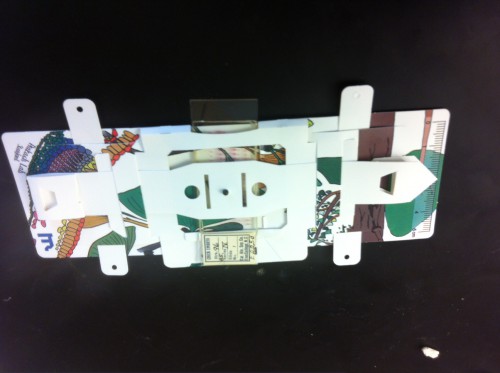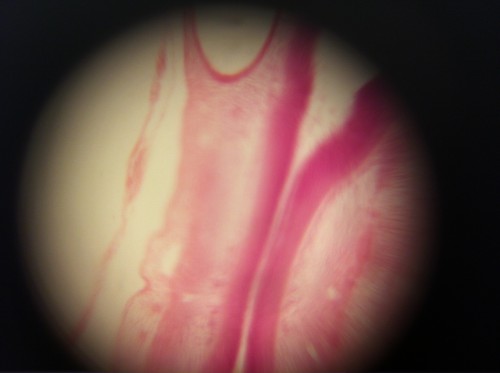I did! It was an origami microscope, with a single simple lens added. Here’s what it looks like:
It’s called a Foldscope, and I got it as part of a beta test program. It’s a bit like the original Leeuwenhoek microscope, which you held up to your eye to see a magnified image.
The differences are that Leeuwenhoek used a drop of water to form a spherical lens; this comes equipped with a pre-printed lens. Leeuwenhoek used brass and little thumbscrews to move the specimen around; Foldscope comes on a sheet of thick paper, and you punch it out and fold it, and then move a slide around under the lens. Leeuwenhoek just aimed the back of his scope at a candle, or sunlight. You can do that with Foldscope, too, or it comes with a little LED source and battery that you can attach to the back. Leeuwenhoek did not have a cell phone camera, so he relied on his ability to draw what he saw. Now we can use magnets and double-stick tape to attach an iPhone to it.
Yes, I know. My iPhone costs a few hundred times what Foldscope does. Even more ironically, I was tinkering with Foldscope in my lab, next to a microscope that costs about 10,000 times more. Here’s a quick photo I snapped of some prepared chick embryo slides I had.
It doesn’t look like much, but this was taken two minutes after fumbling with the gadget. I saw much clearer images with my eye, but the combination of tinkering with my phone and the slide and the Foldscope was poorly practiced. Others are doing much better and are providing tips.
I can say that it’s a better image than anything I saw with my old plastic microscope from Sears that I spent the whole of the summer of 1971 mowing lawns to pay for. It’s a start. I’ll have to practice more.
Apparently, these things only cost a dollar or so to make, so they have a lot of promise for citizen science, low income education projects, or field work. My $20,000 Leica is never leaving my lab bench, but this I can slip in my pocket and take anywhere, and you can imagine equipping a whole room full of kids, or mob of nerds at a SF convention, with these on the cheap.
So tell me, what would you imagine doing if you could get a bunch of microscopes for a dollar each?





Hmm thinking great use at various cons that have a youth track (e.g. Wiscon, Mensa regional conventions, etc.) Set up a series a of planned activities then let the kids take them home afterwords.
also, as you mentioned, use this for schools with low budgets, draw the class into science with minimal overhead.
not sure, lot of options.
A good example of a Leeuwenhoek microscope is those little spit dots on your laptop screen that allow you to see the individual micro whatevers that light the thing up.
These will be a tremendous help to doctors in poorer countries, who often must practice medicine without even basic diagnostic tools. A box with 25 or 50 of these things could be shipped easily and quite cheaply, and would help save many lives.
Damn it. I can’t read “Leica” in a Pharyngula post without thinking of a certain ridiculous someone.
Pixels?
Somewhere I’ve got a cardboard 1/12-scale model of Galileo’s telescope. I’ve not tried pointing it at Jupiter, but it’s good enough for reading a book from the other end of the room (should anyone really wish to do that, I advise employing a small child as a page turner).
There are lots of low-cost little gadgets like this which either have or easily demonstrate sound scientific principles. Some years ago I bought friends a pair of cardboard-and-cheap-motor DIY hovercraft kits; they had great fun racing them around the kitchen floor (I won’t tell you their ages). I second the idea of using gadgets to engage kids with science.
Is it powerful enough to see malaria?
I went to college it Delft University, in the city where Antoni van Leeuwenhoek lived and worked. Therefore a minor pedantic correction: his surname is not ‘Leeuwenhoek’ but ‘van Leeuwenhoek’ (lowercase ‘v’, and a space between). See teh wikipedia entry: http://en.wikipedia.org/wiki/Antonie_van_Leeuwenhoek
Literally translated his name means “Tony from the Lion’s corner”.
This reminds me a bit of this:
http://www.instructables.com/id/10-Smartphone-to-digital-microscope-conversion/
I always found it pretty remarkable the amount of magnification and resolution of detail Leeuwenhoek (it’s either that or he had a very good imagination for turning fuzzy details into detailed drawings, and he was a Time Lord who already knew what things were supposed to look like!) got from his outwardly primitive instruments.
The man was a genius at making lenses….
nycatheist @6
Not sure about malaria, but it can be used for several other common diseases and conditions. IIRC, one of the original purposes of the origami microscope was to permit it to be cheap and compact enough to be single-use like examination gloves and easily/safely disposed of with other medical waste via incineration.
My stepmother got a bunch of these over summer to use in a visiting artist program in local schools here. There are apparently already a lot of plans in the works to send them for medical use in the developing world and educational use everywhere.
Rich@5
A pixel is the smallest element in an image but can be reduced further. AFAIK it takes at least three diodes of varying brightness to make one coloured pixel in an LED display. There’s different technologies and I don’t know which one my computer or yours uses so I used the internationally recognized term whatevers.
I HAVE SEEN THE TED TALK. IT IS WONDERFUL. This is the kind of thing I love to see – innovation that makes things cheaper and more accessible and helps the world.
This looks like it would be ideal to adapt to work with a Raspberry Pi and the camera that goes with the Pi. One could also use the Pi NoIR camera to get near IR images, as well. Even with the electronics, it’d be vastly cheaper than the bench ‘scope.
Did van Leeuwenhoek ever use a water-drop lens? I mean, he certainly could have, but his microscopes were famous for using little glass-bead lenses, the technique for manufacturing which he kept secret.
At the time and for quite a while afterward, people thought van Leeuwenhoek had some tiny intricate grinding gadget, but all he actually did was melt a thread of glass into a bead, and keep it if it came out nice. (Wikipedia says nobody figured this out until 1957!)
I’m going to mention this to our Freethinkers group. We sponsor Camp Quest in our area. Those campers would probably have a lot of fun with a box of these.
This looks suspiciously like Kw*k bait… Did you buy that scope with the money you didn’t use to buy Kw*k a Rangefinder?
Sigh, if only I had a cheap version of a 600 Mhz nmr…..
Nerd: Something tells me that all that liquid helium and superconducting coil business isn’t going to be particularly origami-friendly. /snark
The design of the foldscope makes me think of William Oughtred as much as Leeuwenhoek. As a solution, it’s low tech, but powerful and portable.